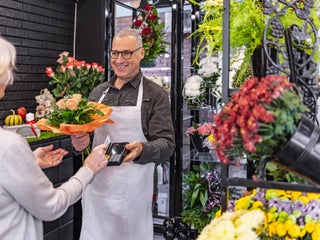Summary
Contactless credit cards are easy to use, efficient, safe and, at this point, ubiquitous. Learn more about how they work as well as whether your card is contactless and how to use it.
The content on this page is accurate as of the posting date; however, some of our partner offers may have expired. Please review our list of best credit cards, or use our CardMatch™ tool to find cards matched to your needs.
Contactless credit cards are pretty mainstream in the U.S. now. So, how do these next-generation chip cards work, and what is different about them?
“Contactless cards make the payment process easier and more efficient,” says Daniel Mouadeb, president of U.S. Card at Capital One. “They eliminate the need for swiping at checkout or dipping your card into the terminal,” he says.
Contactless cards allow you to make payments by tapping your card close to a contactless-enabled point-of-sale terminal, rather than having to insert or swipe it.
At this point, you can assume that most issuers offer contactless cards. If your current card doesn’t have contactless technology, call your issuer and ask if you can request a contactless replacement card.
What is a contactless card?
A contactless card is a chip card with technology embedded in it that lets you pay over a secure radio interface, much like Apple Pay, Android Pay or other mobile wallets.
How do contactless credit cards work?
Contactless cards have “a payments app, per se, all built into the card,” says Melanie Gluck, a vice president at Mastercard. “An antenna picks up when it’s close to a reader and allows info to be transmitted to the point-of-sale terminal.”
You have to be within close proximity — a few inches — to the contactless-enabled credit card terminal for the radio antenna to pick up your card’s signal.
Contactless cards are called dual interface cards because they contain the now standard EMV chip and contactless technology. This way, consumers can use either method depending on what interface merchants are using.
How can you tell if your card is contactless?
So, how do you know if a card is contactless? Easy: Your card will have a contactless symbol — four curved lines that increase in size from left to right – on the front of it.
And to determine if a merchant is contactless-enabled, “just look for the contactless symbol at checkout,” Mouadeb says.
How to use a contactless card
When you go to pay, just position your card within a few inches of the checkout screen. Depending on the screen, you’ll either tap on, above or below it. When you tap your contactless chip card, a cryptographic code is created that’s unique to the card and to the transaction.
“The cryptogram can only be decoded by your bank to validate your transaction,” says Jack Jania, vice president of product management and innovation at CPI Card Group. “It cannot be replayed.”
This process can save the consumer time spent waiting to complete a purchase at the point of sale.
“The bank decides, ‘This is one of my cards, and this is one of my clients’ transactions.’ It’s a handshake between the point-of-sale terminal and the card issuer,” Gluck says. “All of this magic happens in literally 300 milliseconds.”
Where can I use my contactless card?
You can use a contactless card at merchants across the U.S. and typically anywhere — from fast food places to convenience and grocery stores to vending machines. And in some cities, like New York, Portland, Chicago and Miami, you can even use them for public transit.
Each credit card network sets a dollar limit for tap-and-go transactions. Mastercard, for example, has a $200 limit on contactless payments. If a consumer exceeds the card issuer’s limit, they can key in their PIN for additional security.
A contactless card “is designed for lower values, for speed and convenience. It’s not meant for major purchases,” Gluck says.
Bottom line
When you use a contactless card, you just tap and go. Just keep in mind that you’ll be using the feature for making smaller purchases. Think gas stations, convenience stores, grabbing lunch or buying a bus ticket or subway pass where possible.
The advantage? You’ll spend less time waiting in the checkout line, experts say.
Editorial Disclaimer
The editorial content on this page is based solely on the objective assessment of our writers and is not driven by advertising dollars. It has not been provided or commissioned by the credit card issuers. However, we may receive compensation when you click on links to products from our partners.





